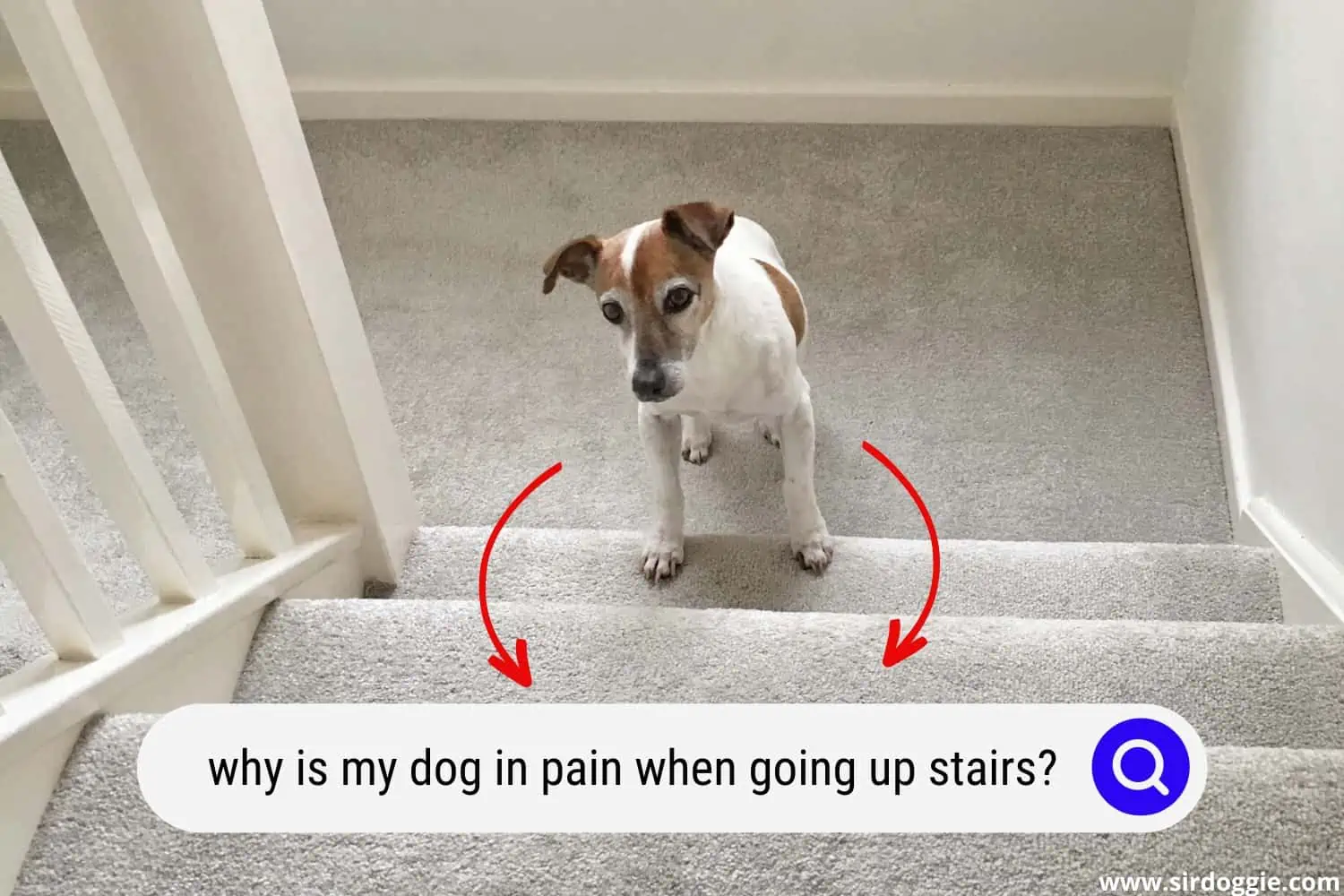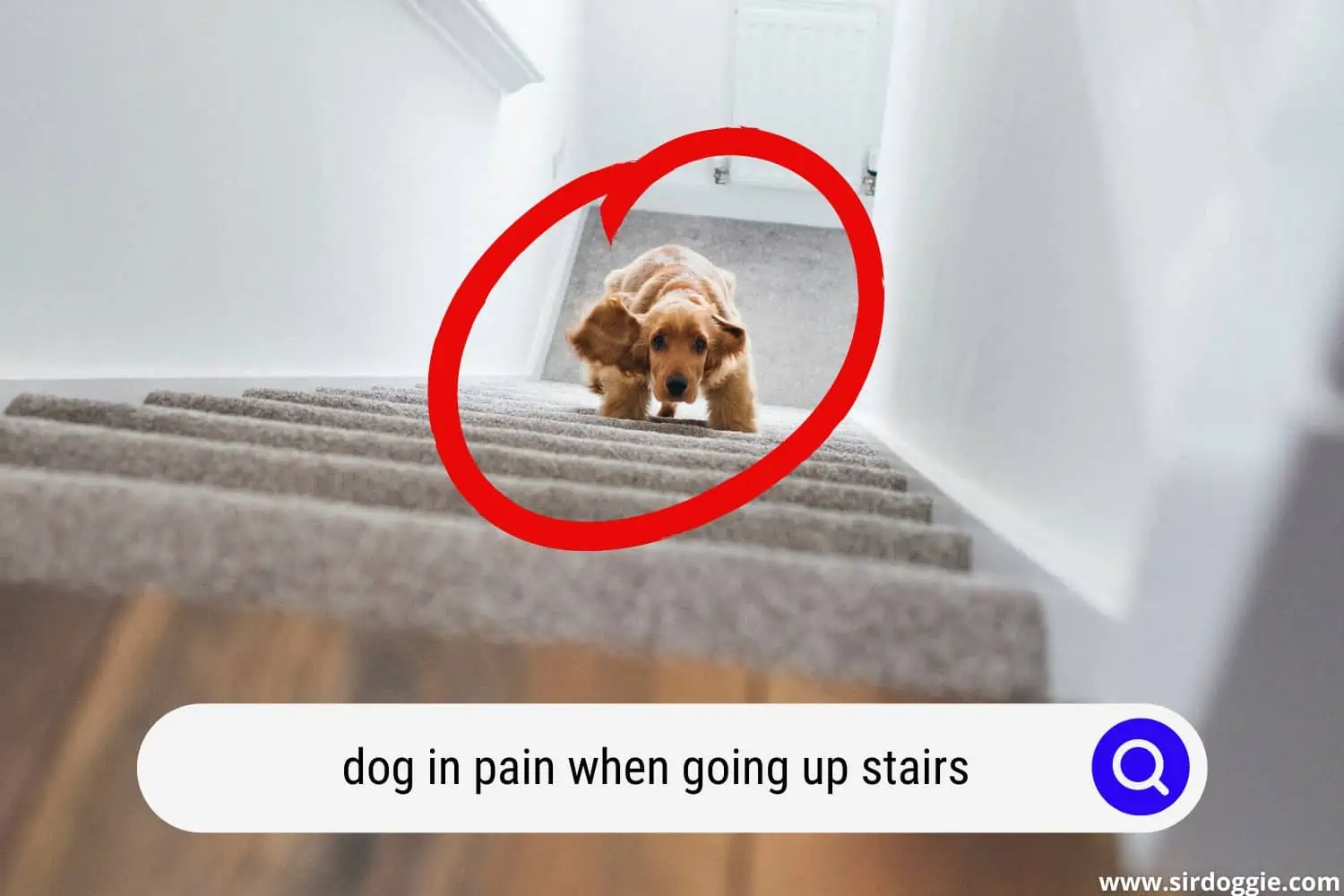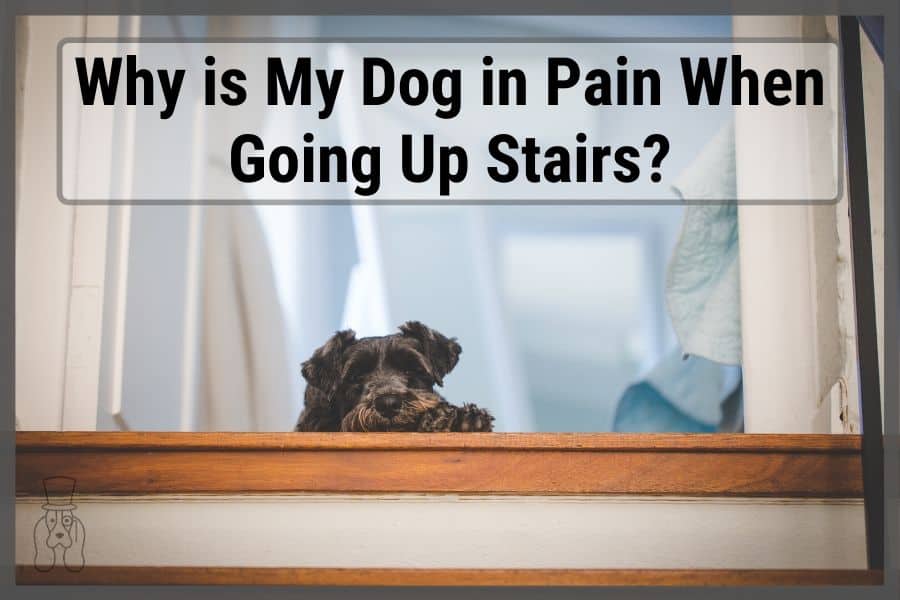Why is My Dog in Pain When Going Up Stairs?
So, why is a dog in pain when going upstairs? The answer may be simple: joint issues. While senior dogs are especially susceptible to joint pain and are more likely to be the ones unwilling to trek staircases, younger dogs may develop a condition due to injury or may even already be liable for joint damage at an early age because of their breed.

Dogs that are reluctant to go upstairs can be that way for a number of reasons, with pain being one of the main explanations.
When your dog begins to avoid the stairs or becomes hostile when being encouraged to go upstairs, it could be a sign that something is up with their physical health.
Throughout this post, we’ll be covering which dog breeds are predisposed to joint pain, how age affects joints, and what to do about it.
Related Reading: Dog in Pain After Shot, What Can I Give Them?
Dog Breeds Susceptible to Joint Damage & Pain When Going Up Stairs
While some dogs go their whole life without much joint pain, other dog breeds have a high risk of pain in the joints and even developing arthritis when they’re middle-aged or senior.
Here, we’ll be taking a closer look at which breeds are predisposed to joint issues.
| German Shepherds | The gentle giant known as the Great Dane is (not shockingly) likely to experience hip or elbow dysplasia and arthritis at some point in their lives. This is because of their rapid growth from puppy to adulthood and their large skeletal frames |
| Great Danes | The gentle giant known as the Great Dane is (not shockingly) likely to experience hip or elbow dysplasia and arthritis during some point in their lives. This is because of their rapid growth from puppy to adulthood and their large skeletal frames |
| Labradors | Like the others on our list, elbow and hip dysplasia and arthritis are all too common in the Lab. Pair that with the fact that Labs are highly at risk to become obese, and you have a pretty well-established recipe for joint pain |
| Chihuahuas | Going on the other end of the size spectrum, these mighty mouses are another dog breed that is susceptible to joint damage — especially damage to the knees. They also suffer from back problems and damage to hips and other joints. This is primarily because of their petite size and always being underfoot, whether that be under the feet of people or under pressure put against them by larger dogs during play. |
| Mastiffs | Like the Great Dane, the massive size of Mastiffs makes them liable to develop joint damage and pain, including arthritis, and hip and elbow dysplasia. |
| Dachshunds | Because of their low, long torsos, Dachshunds, or Weenie Dogs, can develop spinal issues. They’re also quite likely to become obese, adding to the strain on their backs and little legs. |
| Bulldogs | Arthritis and knee damage are among the plethora of issues that these dogs can develop. Their stalkiness and weight can often put tremendous pressure on their joints. |
If you have one of the above dog breeds, it’s best to take preventative measures (we’ll cover more on this, later) as soon as possible to either avoid extreme joint issues like arthritis down the road or lessen the effects that these problems have on your dog.
Senior Dogs, Joint Damage and Pain Going Up Stairs
As dogs age their joints can become less reliable and increasingly more painful. Joint pain and damage are common in practically every breed of senior dog, due to the fact that their bodies are wearing out.
The same fate exists for us humans as well, but we often forget the differences of time between us and dogs.
Stairs especially are a challenge for senior dogs because they are less confident in their ability to navigate the stairs without falling or tripping. They’re also slower to move, and along with the joint pain, their eyesight or hearing may be failing them, adding to their instability.
Signs of Joint Pain in Dogs
Aside from an unwillingness to go upstairs, there are a few signs of joint pain and potentially arthritis, that you should watch out for in your dog.
- Limping: If you notice that your dog is limping or lifting one leg to avoid putting pressure on it, it could be a sign that they are experiencing joint pain.
- Stiffness: If your younger or middle-aged dog isn’t acting as limber as it used to or your old dog is stiffer and slower than usual, this could be a telltale sign of arthritis or joint pain.
- Whimpering: Whining, or sudden yelping when walking are all signs of pain.
- Swelling: Redness of the joints are a visual thing to keep an eye out for.
- Movement: Issues with getting up from the bed or from the floor.
If you notice any of these signs, including reluctance to go up or downstairs, you should take measures to ease the pain and make your dog more comfortable.
A best practice is to always get your doggie checked out by a veterinarian.

How Can I Help My Dog’s Joint Pain?
Though joint damage and pain are common in dogs, and even more common in some breeds, all hope is not lost. There are a few ways in which you can ease joint pain or even prevent it altogether.
If you have a dog breed that is predisposed to joint issues, you should take preventative measures before any signs of pain begin. Here are a few things you should do early in your dog’s life:
- Feed your dog a nutritional diet, focusing on joint health. This is especially important to begin as a puppy. A nutritious diet will prevent your puppy from putting on weight that may put pressure on their developing bones and will also prevent your puppy from growing too quickly and developing bones that are too weak.
- Expose your puppy or adult dog to proper exercise. When a puppy or dog runs on a hard surface, like concrete, it can put immense pressure on their joints and lead to pain later in life. Instead, you should introduce your dog to water play. Swimming is easy on a dog’s bones; it helps keep them fit and is just plain fun for them. You should also consider having two dogs so that they can play with one another. This is often better than having a puppy exercise with you because the two dogs know when they tire, will stop, and begin playing again on their own accord.
- Take your dog to the vet often and ask about supplements. Vet checks can catch joint damage early and may get you and your dog on the proper track to healing and treatment. You should also ask about any supplements that may aid in joint health.
- Avoid making your dog overweight or obese. Obesity can lead to or exasperate joint issues.
Dealing With Existing Dog Joint Pain
If preventative measures are out of the question due to already existing joint pain in your dog, there are a few ways that you can manage the pain and make life easier overall.
The first thing that you can do is to move their bedding, toys, food and water bowls, and anything else that may be upstairs, or downstairs. That way, your dog can avoid the stairs altogether. If there’s no other choice but to go up and downstairs, you can purchase a support harness.
These harnesses are generally placed on the hind end of the dog so that you can support them as they walk. Alternatively, you can purchase a full-body harness to support their whole body rather than making them walk up and down the stairs.
You can also make mealtimes easier by purchasing a raised food and water bowl. This will keep your dog from having to stoop down.
If you notice that your dog is having trouble getting up or down from their bed, consider purchasing an orthopedic dog bed, which conforms to your dog and supports its joints.
One supplement that some pet parents have found to bring relief to their doggies is VetIQ.
Joint supplements for dogs are designed to provide:
- glucosamine
- omega-3
- methysonylmethane
These ingredients, along with others (and in different combinations) help support your dog’s cartilage, helps lubricate joints, and help in maintaining muscles, you can check out a highly-rated supplement by clicking here to view it on Amazon.

Final Notes
If your dog is in pain while going up the stairs the most likely culprit is joint issues.
While senior dogs are especially susceptible to joint pain and are more likely to be the ones unwilling to trek staircases, younger dogs may develop a condition due to injury or may even already be liable for joint damage at an early age because of their breed.
If your dog’s nutrition and exercise aren’t on point, this is likely the first place area to start addressing to help your dog’s pain and joint issues. But as always, having your veterinarian check out your dog is best practice.

Family Dog Expert Author
Hi there! I’m Stuart, a devoted dog lover and family dog expert with over a decade of experience working with our furry companions. My passion for dogs drives me to share my knowledge and expertise, helping families build strong, loving bonds with their four-legged friends. When I’m not writing for SirDoggie, you’ll find me hiking, playing with my beautiful dog, or studying music.